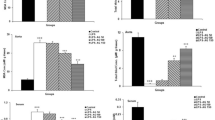Abstract
Induction of the inducible isoform of nitric oxide (NO) synthase (iNOS) in the myocardium is implicated as a mechanism in the development of cardiac depression in immune activated states associated with an enhanced release of cytokines, such as septic shock. We evaluated the in vivo synthesis of NO and tetrahydrobiopterin (BH4), a cofactor of NOS, in the heart tissue using a model of LPS injection in rats (LPS: 10 mg/kg, i.v.). In control rats, iNOS activity or iNOS mRNA in the heart was negligible. Three hours after LPS administration, a marked induction of iNOS mRNA and activity was observed in the heart. A significant increase in BH4 content and GTP cyclohydrolase mRNA abundance was also observed in the heart from LPS-treated rats. Our results demonstrate induction of NO synthesis and parallel increase in BH4 concentration in the heart of rats after LPS treatment in vivo and may provide molecular evidence responsible for the increased production of BH4 which may up-regulate iNOS activity in the heart in vivo. (Mol Cell Biochem 166: 177-181, 1997)
Similar content being viewed by others
References
Abel FL; Myocardial function in sepsis and endotoxin shock. Am J Phys 257: R1265-R1281, 1989
Cunnion RE, Parrillo JE: Myocardial dysfunction in sepsis. Crit Care Clin 5: 99–118, 1989
Dinarello CA: The proinflammatory cytokines interleukin-1 and tumor necrosis factor and treatment of the septic shock syndrome. J Infect Dis 1163: 1177–1184, 1991
Balligand J-L, Kelley RA, Marsden PA, Smith TW, Michel T: Control of cardiac muscle cell function by an endogenous nitric oxide signalling system. Proc Natl Acad Sci USA 90: 347–351, 1993
Balligand J-L, Ungreanu D, Kelley RA, Kobzik L, Pimental, D, Michel T, Smith TW: Abnormal contractile function due to induction of nitric oxide synthesis in rat cardiac myocytes follows exposure to activated macrophage conditioned medium. J Clin Invest 91: 2314–2319, 1993
Schulz R, Panas DL, Catena R, Moncada S, Olley PM, Lopaschuk GL: The role of nitric oxide in cardiac depression induced by interleukin-1β and tumour necrosis factor-α. Brit J Pharmacol 114: 27–34, 1995
Schulz R, Triggle CR: Role of NO in vascular smooth muscle and cardiac muscle function. Trends Pharmacol Sci 15: 255–259, 1994
Thiemermann C, Vane J: Inhibition of nitric oxide synthesis reduces the hypotension induced by bacterial lipopolysaccharides in the rat in vivo. Eur J Pharmacol 182: 591–595, 1990
Gross SS, Levi R: Tetrahydrobiopterin synthesis: An absolute requirement for cytokine-induced nitric oxide generation by vascular smooth muscle. J Biol Chem 267: 25722–25729, 1992
Nathan C, Xie Q-W: Regulation of biosynthesis of nitric oxide. J Biol Chem 269: 25722–25729, 1994
Hattori Y, Gross SS: GTP cyclohydrolase I mRNA is induced by LPS in vascular smooth muscle: characterization, sequence and relationship to nitric oxide synthase. Biochem Biophys Res Commun 195: 435–441, 1993
Hattori Y, Szabo C, Gross SS, Thiemermann C, Vane JR: Lipid A and the lipid A analogue anti-tumour compound ONO-4007 induce nitric oxide synthase in vitro and in vivo. Eur J Pharmacol 291: 83–90, 1995
Fukushima T, Nixon JC: Analysis of reduced forms of biopterin in biological tissues and fluids. Anal Biochem 102: 176–188, 1980
Hattori Y, Shimoda S, Gross SS: Effect of lipopolysaccharide treatment in vivo on tissue expression of argininosuccinate synthetase and argininosuccinate lyase mRNAs: relation to nitric oxide synthase. Biochem Biophys Res Commun 215: 148–153, 1995
Bradford MM: A rapid and sensitive method for the quantification of protein dye binding. Anal Biochem 72: 248–254, 1976
Terada Y, Tomita K, Nonoguchi H, Marumo F: Polymerase chain reaction localization of constitutive nitric oxide synthase and soluble guanylate cyclase messenger RNAs in microdissected rat nephron segments. J Clin Invest 90: 659–665, 1992
Ungreanu D, Balligand J-L, Kelly RA, Smith TW: Myocardial contractile dysfunction in the systemic inflammatory response syndrome: role of a cytokine-inducible nitric oxide synthase in cardiac myocytes. J Mol Cell Cardiol 27: 155–167, 1995
Balligand J-L, Ungreanu D, Simmons WW, Pimental, D, Malinski TA, Kapturezak M, Taha Z, Lowenstein CJ, Davidoff AJ, Kelly RA, Smith TW, Michel T: Cytokine-inducible nitric oxide synthase (iNOS) expression in cardiac myocytes. J Biol Chem 269: 27580–27588, 1994
De Belder AJ, Radomski MW, Why HJF: Nitric oxide synthase activity in human myocardium. Lancet 341: 84–85, 1993
Szabo C, Wu C-C, Thiemermann C, Vane JR: Interleukin-1 contribute to the induction of nitric oxide synthase by endotoxin in vivo. Eur J Pharmacol 250: 157–160, 1993
Thiemermann C, Szabo C, Perretti M, Vane JR: Role of tumour necrosis factor in the induction of nitric oxide synthase in a rat model of endotoxin shock. Br J Pharmacol 110: 177–182, 1993
Author information
Authors and Affiliations
Rights and permissions
About this article
Cite this article
Hattori, Y., Hattori, S., Motohashi, S. et al. Co-induction of nitric oxide and tetrahydrobiopterin synthesis in the myocardium in vivo . Mol Cell Biochem 166, 177–181 (1997). https://doi.org/10.1023/A:1006875707028
Issue Date:
DOI: https://doi.org/10.1023/A:1006875707028




